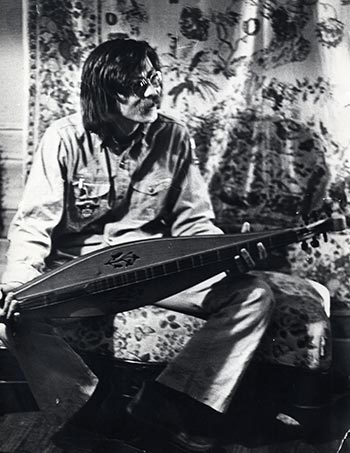Wabash Cannonball
Author: American Traditional
Date/Studio: 1981 Spectrum, Portland, OR
Engineer: Dave Mathew
Producer: Baila Dworsky
Original Release: The Art of Dulcimer (KM217)
Current Release: The Complete Recordings (BSR 158)
 In the Spring of 1971 I decided to throw my life into the dulcimer. I dropped out of college, pointed my pink, 1954 Lincoln Capri toward the Appalachian Mountains, pushed the gas pedal and a week before Easter pulled up to the Sigma Nu fraternity in Knoxville, TN. I took my dulcimer, walked up to the door and knocked. “Do you know what this is?” I asked. “A dulcimer,” the guy replied. “Do you know where they might play them around here?” I continued. “Well,” he said, “There's a festival next week over in Union Grove, North Carolina; they might play them there.” I thanked him and drove off.
In the Spring of 1971 I decided to throw my life into the dulcimer. I dropped out of college, pointed my pink, 1954 Lincoln Capri toward the Appalachian Mountains, pushed the gas pedal and a week before Easter pulled up to the Sigma Nu fraternity in Knoxville, TN. I took my dulcimer, walked up to the door and knocked. “Do you know what this is?” I asked. “A dulcimer,” the guy replied. “Do you know where they might play them around here?” I continued. “Well,” he said, “There's a festival next week over in Union Grove, North Carolina; they might play them there.” I thanked him and drove off.
The night before the start of the 44th Annual Ole Time Fiddlers and Bluegrass Festival I parked my Lincoln in a field, crawled into the back seat and went to sleep. The next morning I was surrounded by thousands of bluegrass pickers. Over the next three days I met two people who were to change my life: Jerry Beall and Albert d'Ossché. Jerry wanted me to learn to build his instruments and come to folk festivals and play them so people would buy them. Albert wanted to learn how to play like I did.
I went to Jerry's in Newark, Ohio to take him up on his offer. While there, for a backpack, sleeping bag and jungle hammock, I traded my Lincoln to a Denison University student also named Lincoln. I told Jerry I'd come back and learn from him but first I needed to check out that Albert guy and hitchhiked to Washington DC. Turned out he was a photographer with credentials for the Vice-President's box in the Senate. He was smart, funny, talented and had just discovered the dulcimer while on a trip to Vermont. We made plans to rendezvous with Jerry at a folk festival up in Cosby, TN.
The 3rd Annual Folk Festival of the Smokies was tiny compared to Union Grove. I hitched in, met the promoters, Jean and Lee Schilling, and strung my hammock in the trees. Al showed up and camped nearby. Jerry came with his van full of dulcimers and a clavichord. I mostly stayed around Jerry's booth and Al and I played some dulcimer together. At that point Al was still mostly a piano player. He really liked the clavichord and we hung out, arranging Baroque treatments for tunes like Shady Grove.
There was a dulcimer competition. That was new to me. I entered. As I was about to step on stage the sound man leaned over and whispered, “Be sure to play something traditional.” “What's traditional?” I asked. “Something over 50-years old,” he replied. My brain was whirling and fastened on my fifth-grade teacher, Mrs. Hahn, and everyone singing the Wabash Cannonball. I launched into it.
I was so shaky and afraid that I played it as fast as I could as best as I could remember. I then quickly left the stage, sick at heart. I made my way back to my hammock and crawled in. I was embarrassed, so sure that everyone thought I was stupid. Appalachian folk tune-- hah! Laying there I heard the rest of the performers. There was a short break and then the announcement I had won. “Oh, man, I wasn't even there to accept the award. Now they must think I'm conceited.” Something new to worry about.
The judges concurred I probably adapted my version in the free improvisation style of Birmingham's, Sun Ra. I was 22. It was cool to win and be compared to a great musician. But I remembered how I had recently felt. I vowed I would never again enter a contest for music and I never have. I also vowed that day to really learn the tune-- to own it-- to make it distinctly my own with bells and whistles, percussive backbeats and a train that goes faster and faster, then fades in the distance-- and I have.
A lot of the techniques I developed to play this tune have stood me in good stead and have shown up in other of my tunes over the years-- notably the cross-string walk-over and the “chuffing” syncopated muting of the strings. Mrs. Hahn is probably no longer on the planet so instead of thanking her, I thank all of you elementary teachers who are putting songs into the hearts of kids. You never know...
